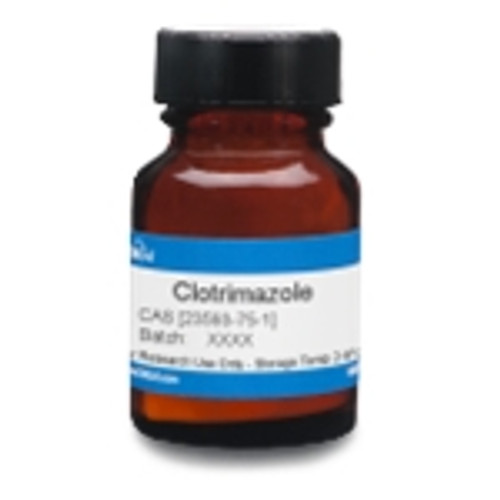Clotrimazole is a broad-spectrum antifungal belonging to the imidazole subclass of azole compounds. These compounds interfere with the biosynthesis of ergosterol, a major membrane component of the fungal cytoplasmic membrane. Clotrimazole was discovered in 1969 and was developed by Schering Plough. It inhibits Ca2+-activated potassium channels and has promising anti-cancer effects. Clotrimazole is also a reversible inhibitor of several cytochrome P450 (CYP450) isoforms. In vitro-based CYP450 enzyme inhibition screening has been used to evaluate compound interactions.
This product is considered a dangerous good. Quantities above 1 g may be subject to additional shipping fees. Please contact us for details.
| Application | Clotrimazole is a reversible inhibitor of cytochrome P450 (CYP450). In vitro-based CYP450 enzyme inhibition screening has been used to evaluate compound interactions (Yan et al, 2002). |
| Mechanism of Action | Clotrimazole increases fungal cell permeability by inhibiting ergosterol synthesis, a major cell membrane component found exclusively in fungi, resulting in fungistatic properties. Specifically, it inhibits the microsomal cytochrome P450-dependent 14α-demethylase, which is critical to ergosterol biosynthesis. |
| Spectrum | Clotrimazole is broad-spectrum antifungal, targeting a broad range of fungi including Candida and Aspergillus species. |
| Eukaryotic Cell Culture Applications | Clotrimazole can be used to inhibit CYP450 in cell cultures. |
| Cancer Applications | Clotrimazole has promising anti-cancer properties, interfering with glycolytic enzymes, specifically their cellular distribution and activity. Clotrimazole induced a dose-dependent decrease in glucose uptake in three cell lines from human breast cancer cell lines (MCF10A, MCF-7 and MDA-MB-231), affecting the metabolism, growth, and migration. The compound was non-toxic to non-tumor human breast cell lines (Furtado et al, 2012). |
| References |
Crowley PD and Gallagher HC (2014) Clotrimazole as a pharmaceutical: Past, present, and future. J. Appl. Microbiol. 117(3):611-617 Furtado CM, Marcondes MC, Sola-Penna M, de Souza MLS, and Zancan P (2012) Clotrimazole preferentially inhibits human breast cancer cell proliferation, viability and glycolysis. PLoS ONE 7(2): e30462 Jensen BS, Strøbaek D, Olesen SP, Christophersen P (2001) The Ca2+-activated K+ channel of intermediate conductance: A molecular target for novel treatments? Curr. Drug Targets 2(4):401-422 PMID 11732639 Rice LB and Ghannoum MA (1999) Antifungal agents: Mode of action, mechanisms of resistance, and correlation of these mechanisms with bacterial resistance. Clin. Microbiol. Rev. 12(4):501-517 PMID 10515900 Yan Z, Rafferty B, Caldwell GW and MAsucci JA (2002) Rapidly distinguishing reversible and irreversible CYP450 inhibitors by using fluorometric kinetic analyses. E. J. Drug Metab. and Pharmacokin. 27(4):281-287 |



